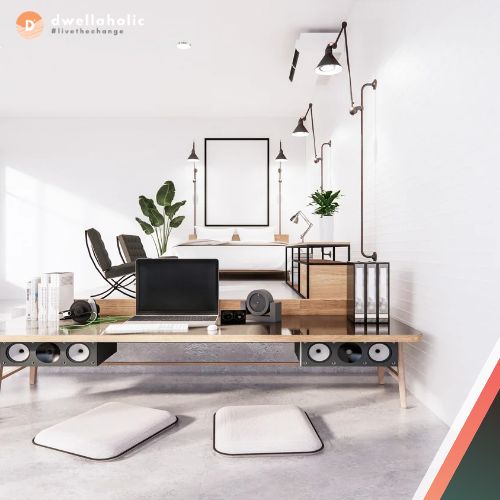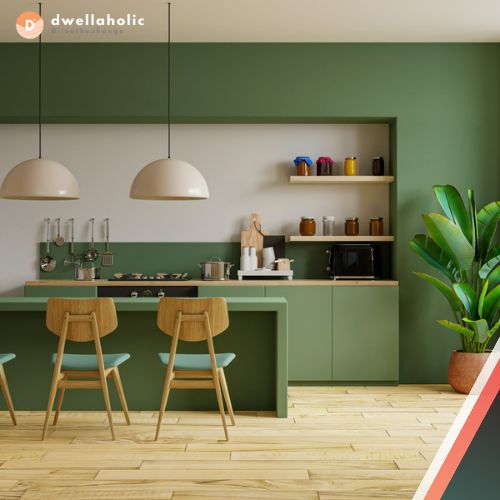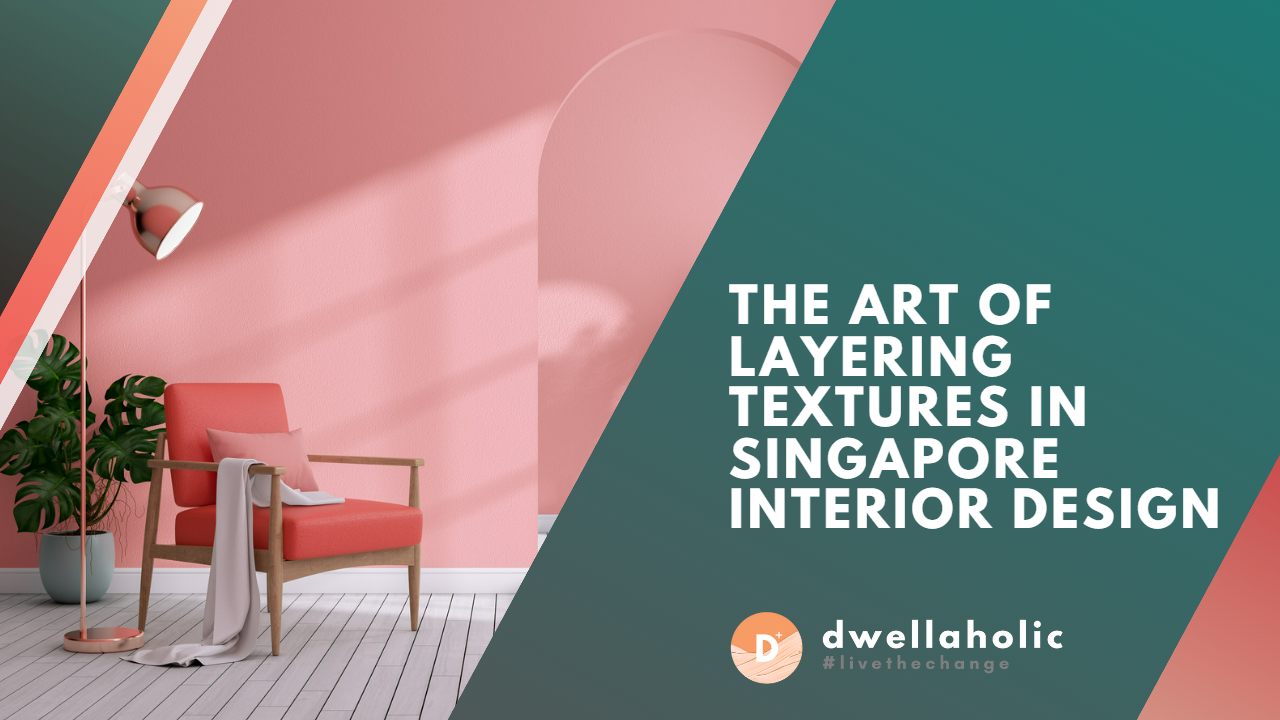Table of Contents
- 1 Introduction
- 2 Understanding Textures in Interior Design
- 3 The Art of Layering Textures: A Designer’s Secret Weapon
- 4 Common Textures Used in Singapore Interior Design
- 5 How to Layer Textures in Your Home
- 6 Using Textures for Different Design Styles
- 7 The Role of Lighting in Highlighting Textures
- 8 Living Room
- 9 Bedroom
- 10 Dining Room
- 11 Conclusion
- 12 How Dwellaholic Can Help You Create Your Dream Space with Our ID Expertise
- 13 Contact Dwellaholic
Introduction
One of the most effective ways to add depth, warmth, and personality to your home is to layer different textures. Textures can create contrast, balance, and harmony in any space, as well as evoke certain moods and emotions. However, layering textures can also be tricky, especially in Singapore where the climate is hot and humid. How do you layer textures without making your home look cluttered, heavy, or stuffy? In this blog post, we will share some tips and tricks on how to master the art of layering textures in Singapore interior design. Whether you want to create a cozy, rustic, modern, or eclectic vibe, you can find the right textures to suit your style and preference.
Understanding Textures in Interior Design
As an interior designer, I understand the importance of textures in creating a well-designed space. Here’s everything you need to know about textures in interior design:

Explanation of Textures in Interior Design
Textures refer to the surface quality of materials in a space. It includes the tactile, visual, and even auditory properties of a surface. Textures can be rough or smooth, soft or hard, shiny or matte, and can come from a variety of materials such as wood, metal, fabric, and more. Incorporating different textures into a space can add depth, interest, and dimensionality.
Importance of Textures in Creating a Well-Designed Space
Textures play a crucial role in creating a well-designed space. Here’s why:
- Adds depth and interest: Incorporating textures into a space adds visual interest and depth, making it more visually appealing.
- Creates contrast: Contrasting textures can help create a focal point in a space and make certain elements stand out.
- Elevates a design: Adding different textures can add a sense of luxury and sophistication to a space.
- Enhances tactile experience: Textures not only look good, but they also add a tactile experience that can be pleasing to the touch.
Different Types of Textures
There are various types of textures that can be incorporated into a space, including:
- Smooth textures: These include materials like glass, metal, and polished stone, which reflect light and give a sleek and modern look.
- Rough textures: These include materials like brick, stone, and unpolished wood, which add a natural and rustic feel to a space.
- Soft textures: These include materials like fabrics, such as velvet, chenille, and wool, which add warmth and coziness to a space.
- Hard textures: These include materials like concrete, ceramic, and glass, which can add an industrial and edgy vibe to a space.
The Art of Layering Textures: A Designer’s Secret Weapon
Why Layering Textures is a Game-Changer
As a Dwellaholic, I can’t stress enough the impact of layering textures in interior design. It’s like the secret sauce that gives a space that coveted je ne sais quoi. By incorporating various textures, you create depth and visual interest, making your room feel cozy, inviting, and simply fabulous.
Enriching Your Space with Texture
Now, why should you care about texture layering? Here’s the scoop:

- Instant Character: Layering textures adds personality and warmth to any space, making it feel truly lived-in.
- Hide Flaws: Cleverly placed textures can help disguise imperfections in walls or furniture.
- Aesthetic Harmony: Mixing textures creates a beautiful balance, preventing your space from looking flat or dull.
Mastering the Texture Mix in Different Spaces
Ready to dive into the world of texture layering? Let’s break it down room by room:
- Living Room: Combine a plush rug with a velvet sofa, throw pillows in various fabrics, and a knitted blanket to create a space that’s begging for movie nights and long chats.
- Bedroom: Experiment with linen bedspreads, a faux fur throw, and a textured headboard for a dreamy, cloud-like haven.
- Kitchen: Play with patterned tiles, wooden countertops, and a mix of metal finishes for a kitchen that’s as stylish as it is functional.
Common Textures Used in Singapore Interior Design
Top Textures in Singapore’s Stylish Spaces

As a Dwellaholic, I’ve noticed that Singapore’s interior design scene has a particular flair for mixing textures. Embracing both tradition and modernity, you’ll find a medley of materials that create effortlessly chic spaces. Let’s take a closer look at the common textures used in Singapore’s interior design:
- Rattan: A classic choice, rattan adds an organic touch and a nod to Singapore’s heritage.
- Wood: Whether it’s teak or oak, wood is timeless and versatile, lending warmth and sophistication.
- Concrete: For an edgy, industrial feel, concrete is a go-to choice that’s both stylish and practical.
- Terrazzo: This composite material, made of marble, quartz, and other stones, adds a playful, colorful touch.
Natural Textures: Embracing Singapore’s Rich Environment
Singapore’s love for natural materials goes beyond just rattan and wood. Here’s a taste of the local design scene’s affection for nature:
- Green Walls: Lush vertical gardens bring the outdoors in and create a peaceful sanctuary in urban spaces.
- Stone: Incorporating raw, natural stone adds an earthy and grounding element to any room.
Weaving Natural Textures into Modern Spaces
Ready to introduce some Singaporean texture magic into your modern space? Here are some quick tips:
- Balance: Combine sleek, modern surfaces with natural textures to strike the perfect balance.
- Accent Pieces: Introduce rattan or wooden accessories, like a side table or a statement mirror, to add a touch of organic warmth.
- Go Green: Incorporate indoor plants to breathe life into your space and complement natural materials.
How to Layer Textures in Your Home
Layering textures in your home is a great way to add depth and interest to your living spaces. It’s a simple yet effective way to make your home feel cozy and inviting. Here are some tips for layering textures in different areas of your home.

- Mix and match: Don’t be afraid to mix and match different textures. Combining textures such as wood, metal, and fabric can create a unique and visually appealing look. Just make sure to balance the textures properly so that your space doesn’t look too cluttered.
- Vary the scales: Use different textures in varying scales to create interest. For example, a large textured rug paired with small textured throw pillows can add depth and dimension to a space.
- Consider the color scheme: When layering textures, consider the color scheme of your space. Choose textures that complement the existing color palette to create a cohesive look.
- Play with patterns: Mix and match different patterns to add even more texture to your space. Just make sure to balance the patterns so that they don’t overwhelm the space.
- Add natural elements: Incorporating natural textures like wood, plants, and stone can add warmth and texture to your home. They also add a touch of nature, which can create a calming and relaxing atmosphere.
- Use layers to create depth: Layering textures can create depth and interest in a space. For example, layering a cozy throw blanket over a textured sofa can create a cozy and inviting space.
By following these tips, you can create a cohesive and visually appealing look in your home with layered textures. Don’t be afraid to experiment with different textures and patterns to find a combination that works for you.
Using Textures for Different Design Styles
Textures are a great way to add depth and interest to any space, but did you know that different textures can be used to achieve different design styles? As an interior designer and self-proclaimed dwellaholic, I love playing with textures to create unique and personalized spaces. Here are some tips on how to use textures to achieve different design styles:
Minimalism

Minimalist design is all about simplicity and clean lines. When it comes to textures, less is definitely more. Stick to simple, natural textures such as:
- Matte finishes
- Smooth surfaces
- Natural woods
To keep the space from feeling too cold or sterile, consider adding a cozy throw or soft rug in a neutral color.
Industrial
Industrial design is all about embracing the raw and unfinished. To achieve this look, incorporate textures such as:
- Rough, exposed brick walls
- Concrete floors or countertops
- Metal finishes such as steel or iron
To soften the space and make it feel more livable, consider adding cozy textures like a plush area rug or soft throw pillows.
Bohemian
Bohemian design is all about embracing color and texture. To achieve this look, mix and match different textures such as:
- Bold patterns and prints
- Fringe and tassels
- Woven textiles such as macrame or rattan
Don’t be afraid to incorporate bold colors and patterns, and add layers of texture with throw blankets and pillows.
Textures can be used to achieve a variety of different design styles, from minimalist to bohemian. The key is to use textures in a way that complements the overall design aesthetic. Don’t be afraid to experiment and have fun with textures – after all, design should be a reflection of your personality and style.
The Role of Lighting in Highlighting Textures
Lighting can be used to highlight the beauty and depth of different textures, creating a dynamic and visually appealing environment. Here are some tips on how to use lighting to highlight textures in different spaces:
Living Room
In the living room, consider using a combination of overhead and accent lighting to showcase textures such as:
- A textured area rug
- A plush, velvet sofa
- A woven throw blanket
Use overhead lighting to create a bright and welcoming space, and add accent lighting to highlight specific textures and create a cozy ambiance.

Bedroom
In the bedroom, use lighting to create a relaxing and calming atmosphere. Consider using:
- Soft, ambient lighting
- A bedside lamp with a textured shade
- A pendant light with a unique texture
Lighting can also be used to highlight the textures of bedding and window treatments.
Dining Room
In the dining room, lighting is key for creating a warm and inviting atmosphere. Consider using:
- A statement pendant light with a textured shade
- Candlelight or dimmer switches to create a cozy ambiance
- Textured table linens and napkins to add depth and interest
Proper lighting can help highlight the textures in a space, making it feel more dynamic and visually appealing. By following these tips, you can use lighting to create a cozy and inviting environment that showcases the beauty of different textures.
Conclusion
In conclusion, layering textures is a crucial element in Singapore interior design as it adds depth and interest to any living space. By mixing and matching different textures, varying the scales, considering the color scheme, playing with patterns, adding natural elements, and using layers to create depth, homeowners can achieve a cohesive and visually appealing look in their homes. From cozy and inviting to modern and edgy, the possibilities are endless when it comes to layering textures in interior design. As an interior designer and self-proclaimed dwellaholic, I highly recommend experimenting with different textures to create a personalized and unique space that reflects your personality and style. With the right combination of textures, you can transform any space into a warm and inviting oasis that you’ll love coming home to.
How Dwellaholic Can Help You Create Your Dream Space with Our ID Expertise

Residential Design Expertise Dwellaholic specializes in creating stunning and functional residential designs that cater to your specific needs and preferences. They’re committed to transforming your space into a comfortable and stylish haven, making it the perfect spot for relaxation and enjoyment.
Commercial Design Skills Aside from residential projects, Dwellaholic also excels in commercial design. Their team of experts understands the unique requirements and challenges of designing for businesses, and they’re dedicated to crafting spaces that are both visually appealing and highly efficient.
Tailored Solutions Dwellaholic takes the time to truly understand your design needs, ensuring that every solution is tailored to your specific requirements. They believe in creating unique spaces that reflect your personal style, while also being functional and practical.
Top-notch Professionals The Dwellaholic team consists of experienced and talented professionals who are dedicated to their craft. They work tirelessly to create exceptional designs, ensuring that your space is both beautiful and functional.
Great Customer Service Dwellaholic prides itself on providing exceptional customer service, making sure that every client feels heard and valued. They’re always available to answer questions, provide guidance, and address any concerns you might have throughout the design process.
Choose Dwellaholic for an Unforgettable Design Experience
In conclusion, choosing Dwellaholic for your residential or commercial design needs means investing in top-quality, personalized, and innovative design solutions. Their dedication to client satisfaction, paired with their exceptional team of professionals, makes them the ideal choice for creating the space of your dreams. Don’t wait any longer—get in touch with Dwellaholic today and embark on an unforgettable design journey.
Get started on your next design project with Dwellaholic and let us bring your vision to life!
Contact Dwellaholic
- Name: Angela / Dwellaholic
- Mobile: +65 9048 8048
- Email: [email protected]


